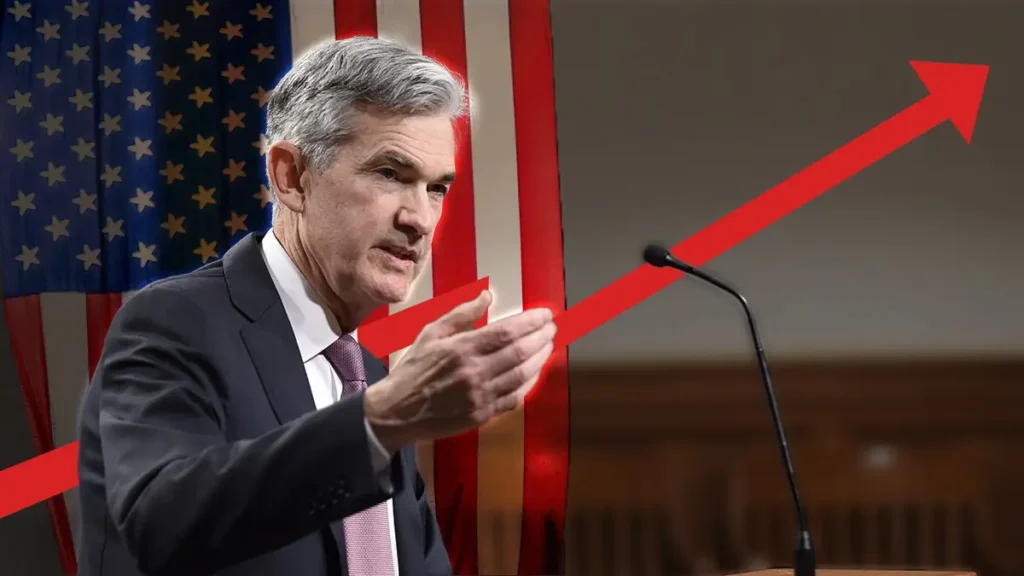On Thursday, Federal Reserve Chairman Jerome Powell shared that he and his colleagues feel hopeful about slowing down the inflation.
However, there is uncertainty about whether their efforts have been sufficient to maintain this positive trend.
Just over a week after the central bank decided to keep policy rates steady, Powell, speaking to an International Monetary Fund audience in Washington, D.C., mentioned that there might be more work ahead in tackling high prices.
The Federal Open Market Committee aims for a monetary policy that curtails inflation to 2 percent over time.
Powell stated there’s uncertainty about attaining this goal, as stated in the prepared speech.
Powell’s public address faced interruption from climate protesters for the second time in recent weeks, leading to a brief exit from the stage before resuming his speech.
The speech occurs amid inflation persistently above the Fed’s long-standing goal but notably lower than its peak in the first half of 2022.
The committee executed 11 rate hikes, the most aggressive since the early 1980s, elevating the benchmark rate from near zero to a target range of 5.25%-5.5%.
The rate hikes align with the Fed’s preferred inflation measure, the core personal consumption expenditures price index, dropping to an annual rate of 3.7% from 5.3% in February 2022.
The consumer price index, more widely tracked, peaked above 9% in June of the previous year.
Powell mentioned that inflation is “well above” the Fed’s desired level and characterized the current policy as “significantly restrictive.”
“My colleagues and I are pleased with the progress, yet acknowledge a prolonged journey to achieve sustained inflation at 2 percent,” Powell stated.
He affirmed the commitment to persist until success, emphasizing the focus on assessing if rates should rise and how long they should stay elevated.
Stocks drop, treasury yields surge after Fed warning on rate cuts
Following the speech, stocks declined, with the Dow Jones Industrial Average dropping nearly 200 points. Treasury yields, which have been decreasing for the past three weeks, surged higher, largely influenced by a poorly received 30-year bond auction.
Jeffrey Roach, a chief economist at LPL Financial, noted that Chairman Powell warned investors too giddy on the prospect of rate cuts next year. The Fed will stay true to its mandate and hike further should inflation reaccelerate.
Emphasizing a recurring theme in recent speeches, Powell highlighted the Fed’s cautious approach. He is recognizing the delicate balance between doing too much and too little. He noted the Fed’s awareness of the increase in Treasury yields.
Powell affirmed, that if it becomes appropriate to tighten policy further, the Fed will not hesitate.
They will continue to move carefully, allowing them to address both the risk of being misled by a few good months of data and the risk of overtightening.
Powell stated that Monetary policy is generally working the way we think it should work.
Market confidence in Fed’s interest rate pause
Markets are widely convinced that the Fed has concluded its rate hikes.
CME Group’s futures pricing suggests less than a 10% probability of the FOMC approving a final rate hike at its Dec.
12-13 meeting, despite earlier indications by committee members in September for an additional quarter percentage point rise by year-end.
Traders anticipate that the Fed will initiate rate cuts next year, with expectations centered around a possible start in June.
Powell acknowledged the economy’s progress, citing a “quite strong” 4.9% annualized pace of gross domestic product in the third quarter.
Despite this, he anticipates moderate growth in coming quarters and characterized the economy as remarkable in 2023, defying a broad consensus predicting an inevitable recession.
Powell flags some concerns
Despite low unemployment, Powell highlighted a half-percentage point rise in the jobless rate this year, a trend often linked with recessions.
He emphasized the Fed’s vigilance, acknowledging that unexpectedly robust growth could pose a challenge to the fight against inflation, potentially necessitating a response from monetary policy.
Powell highlighted that supply chain enhancements have alleviated inflation pressures, but he expressed uncertainty about the extent of further improvements.
Looking ahead, he suggested that a significant portion of progress in reducing inflation might rely on tight monetary policy to restrain the aggregate demand growth.
These remarks were part of a comprehensive presentation Powell delivered at the Jacques Polak Annual Research Conference.
Among the policy topics, he addressed the challenge of maintaining rates near zero, their level before the inflation surge.
Powell stated that it is too soon to determine if challenges associated with zero rates are “a thing of the past.”
Read More: US Inflation report may prompt concerns for Fed’s 2% goal

